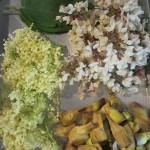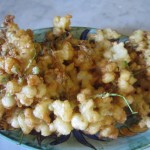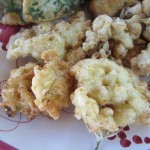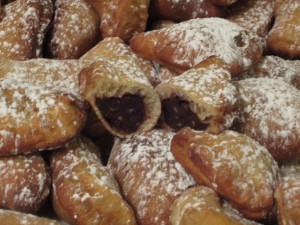 After all the cold rain of April we are rewarded with the burgeoning flowers of May. Poppies, roses and peonies cover the Tuscan landscape. Acacia is rampant along highways, turning miles of roads into soft white shoulders. Elder flowers dot dark elder bushes throughout the countryside and I’m preoccupied with how best to get at them while they’re in their prime. Both acacia and elder are edible and I love adding them to a simple fried antipasto along with baby artichokes and the big sage leaves that come out in the spring. It’s a brief, fleeting season and so we have to hurry.
After all the cold rain of April we are rewarded with the burgeoning flowers of May. Poppies, roses and peonies cover the Tuscan landscape. Acacia is rampant along highways, turning miles of roads into soft white shoulders. Elder flowers dot dark elder bushes throughout the countryside and I’m preoccupied with how best to get at them while they’re in their prime. Both acacia and elder are edible and I love adding them to a simple fried antipasto along with baby artichokes and the big sage leaves that come out in the spring. It’s a brief, fleeting season and so we have to hurry.
Acacia smells beautiful, reminiscent of orange blossom, with white droplets bunched together like grapes, drooping from the branches. Acacia is everywhere and generally has branches that grow within reach, giving easy access to the flowers.
The elder (sambuco in Italian) has an unusual smell with large pale yellow lace-like flowers against dark green leaves. It is more difficult to pick as the bushes tend to grow on steep slopes on the sides of roads, maddeningly just out of reach.
I first fell in love with fried elder flowers when I was little girl in Italy and my mother learned how to fry them, which is common in the area around Verona. Not understanding the concept of seasons, I would bring flowers home all year long that I hoped were the right blossoms for frying. I was so often disappointed. Elder isn’t eaten or used much in Tuscany but in the northern regions they make tinctures and syrups of both the flowers and the berries.
The batter is the simplest thing in the world and you make just  however much you think you’ll need for the flowers and leaves you want to fry. Put flour in a bowl with a little salt. With a whisk start pouring white wine and stirring to incorporate. Use just enough wine that you have a batter the consistency of crepe batter. Heat peanut or grapeseed oil on a high heat, dip your flowers into the batter and put them in the oil. Turn them when they’re golden brown, not too dark, and drain them on paper towels.
however much you think you’ll need for the flowers and leaves you want to fry. Put flour in a bowl with a little salt. With a whisk start pouring white wine and stirring to incorporate. Use just enough wine that you have a batter the consistency of crepe batter. Heat peanut or grapeseed oil on a high heat, dip your flowers into the batter and put them in the oil. Turn them when they’re golden brown, not too dark, and drain them on paper towels.
In the summer we have zucchini blossoms and sage leaves, but in the spring we celebrate the short season of acacia and elder blossoms. If you can’t find any flowers to fry, try small artichokes, zucchini slices and mushrooms. Buon appetito!



 Growing up on the east coast, we always spent the Christmas holidays with my father’s family in Brooklyn. Driving up from DC the day after Christmas, we’d arrive in time to for dinner. The house was decorated and warm with lights and garland, every dinner was festive and dessert always included a big platter of fried pastry: struffoli sprinkled with tiny colored confection balls and long strips of crunchy dough drizzled with honey; but my grandmother’s specialty were her chestnut ravioli. Chestnuts come from her hometown of Montella, in the mountains of Campania just to the east of Naples, and she prided herself on this delicious Christmas specialty. Flavored with cocoa and various liquors, chiefly the southern Italian strong tasting Strega, it was never my favorite as a child, so I politely ate the chewy fried pastry around the filling and hid the dark, strong chestnut filling in a napkin.
Growing up on the east coast, we always spent the Christmas holidays with my father’s family in Brooklyn. Driving up from DC the day after Christmas, we’d arrive in time to for dinner. The house was decorated and warm with lights and garland, every dinner was festive and dessert always included a big platter of fried pastry: struffoli sprinkled with tiny colored confection balls and long strips of crunchy dough drizzled with honey; but my grandmother’s specialty were her chestnut ravioli. Chestnuts come from her hometown of Montella, in the mountains of Campania just to the east of Naples, and she prided herself on this delicious Christmas specialty. Flavored with cocoa and various liquors, chiefly the southern Italian strong tasting Strega, it was never my favorite as a child, so I politely ate the chewy fried pastry around the filling and hid the dark, strong chestnut filling in a napkin.



